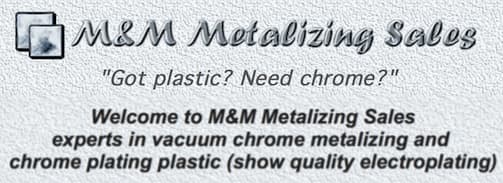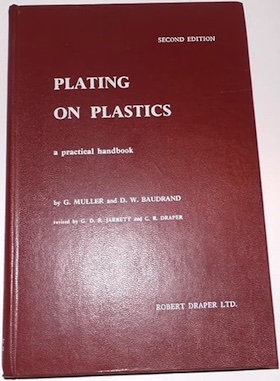
Curated with aloha by
Ted Mooney, P.E. RET

The authoritative public forum
for Metal Finishing 1989-2025

-----
Plating vs. vacuum metallizing vs. chrome-look painting of plastic
Q. Hi,a) please advise the types of plastic able to be plated.ABS, PC, PC/ABS blends?b) Masking or selective plating able to achieve for plating process?c) Nominal thickness for the plating?d) The plating materials used in the industryHow about the materials for VM-process?Thanks,
Dave Chongelectronics - Singapore
2005
A. It is best to start by selecting a major plating chemical supplier of proprietary products. The plating on plastics is a complex process. ABS, plating grade, is best to start. Suppliers can advise all the steps, equipment etc you need for this process. If you have questions after consulting suppliers, I can be of assistance. I have written papers and a book on plating plastics.

Don Baudrand
Consultant - Poulsbo, Washington
(Don is co-author of "Plating on Plastics" [on Amazon or AbeBooks affil links]
and "Plating ABS Plastics" [on Amazon or eBay or AbeBooks affil links])
2005
Q. What are the pros and cons of electroplating plastic vs. Vacuum Metallizing Plastic? I'm looking for items such as cost, durability, range of color and finish options, etc. Thanks in advance.
Frank Annerino- Rolling Meadows, Illinois
November 18, 2015
A. Hi Frank. Until a decade or so ago you could deposit a shiny chrome-like metallic finish on plastic by either chrome electroplating or vacuum metallizing. Today there is an additional way, 'chrome-look paint'.
Vacuum metallizing and chrome look paint are actually rather similar in method and result. In both cases there are three layers required:
1) a base coat of clear or white paint that adheres well, is very smooth, and upon which the second layer can sit smoothly for good reflection while adhering well.
2) a second very thin layer of vacuum deposited aluminum, or a sprayed coating of tiny aluminum flakes or reduced silver nitrate (like used in mirrors) to provide the shine.
3) a clear coat (or tinted translucent top coat if colors are wanted) to protect the very thin shiny layer from oxidizing or wearing away.
The biggest difference between these two methods is thus probably not performance, but capital vs. labor cost. It may cost $1/2 million to $1 million for a vacuum chamber, probably more for high production or large parts; but for high volume, the production cost is low because it's well automated. Chrome-look paint lets you use inexpensive paint spraying equipment instead of a costly vacuum chamber, but quality spraying of the reflective layer is way more labor intensive than cycling parts through a vacuum chamber -- and the materials are expensive so mistakes are costly. So the choice between vacuum metallizing and chrome-look paint is mostly based on the economics of capital expenditure vs. labor cost.
Electroplated plastic, though, has real metal (copper, nickel, and chrome) deposited on it, and is much more complicated and expensive but much, much more durable than the other approaches. Please see our "Introduction to Chrome Plating" page. Electroplated plastic is used for automobile grills and other exterior parts. Vacuum metallizing is used for protected parts like the shiny reflective areas under a headlight lens that are sealed away from the environment, and interior (cabin) parts of the automobile (armrests, dashboards).
The question really becomes "what kind of parts and application are you talking about" because the difference is not subtle: if vacuum metallizing will suffice, it will be much cheaper than electroplating. Nobody chrome plates a Cracker Jax prize, but nobody vacuum metallizes an automobile grill. Good luck.
Regards,

Ted Mooney, P.E. RET
Striving to live Aloha
finishing.com - Pine Beach, New Jersey
A. I would like to add that Electroless Copper/Cobalt plating is an alternative to Real chrome plating and one can mix some features of Vapor Deposition to our advantages.
In the PVD coating process an adherent coating is applied to ABS or other plastics that works as an adhesion promoter and as a glossy base onto which the metal layer will stick. Something similar is used on spray-on chrome for the same reasons (to provide an adherent and shiny layer) because otherwise if these type of thin coatings were to be deposited on rough or matte surface their reflectivity will be null.
I have personally attested to this.
An ABS article is properly prepared to receive a 2k clear coat (two part/Catalyzed) that will serve as Adherent basecoat (as opposed to ABS or other plastics that are very problematic to get metal to adhere).
This basecoat no longer needs chemical or physical etching. The article is sensitized with stannous chloride (5 gm SnCl2 20 ml of HCl per Liter) for 30 to 60 seconds, Rinsed and then activated by Palladium chloride (0.5 to 0.1 gm PdCl2 10 ml of HCl per liter).
This activated ABS article can now be electroless plated directly by Copper or Nickel/Cobalt with a mirror like finish due to the adherent glossy base coat. The article can be further plated with gold (electroless immersion or electric) if desired.
- Managua, Nicaragua
January 14, 2016
Thank you Marvin! Quite interesting.
Regards,

Ted Mooney, P.E. RET
Striving to live Aloha
finishing.com - Pine Beach, New Jersey
Cosmichrome spray system for chroming
Q. I am involved in the automotive customization business and I am looking for including the chroming service as well. I have been searching the internet to find and buy a chroming system and found that a company called Cosmichrome in Canada represented by the USA company Gold Touch [a finishing.com supporting advertiser] offer such a system. The system is called COSMICHROME SPRAY SYSTEM.
Has any of you ever used their system and what is your impression? Can any of you experts tell me if their system really works or not? Is any of you using a different system that really works and would like to suggest it? I would appreciate it if you could answer to my questions. Best regards,
Automotive customisation - Larnaka, Larnaka, Cyprus
July 11, 2016
A. Hi Vassilis. Cosmichrome is one brand of "chrome look paint". On this relatively anonymous, no-registration-required site, we do not compare the offerings of one company against another. It leads to hostility, phony postings from sales people pretending to be satisfied customers, etc. We are happy to discuss the merits of chrome look paint vs. vacuum metallizing vs. real chrome electroplating, but cannot compare one brand of chrome-look paint to another.
Regards,

Ted Mooney, P.E. RET
Striving to live Aloha
finishing.com - Pine Beach, New Jersey
July 2016
Vacuum metallizing (chroming) plastic
Q. Hi,
I'm interested in restoring the chrome look on older 60s and 70s cars for myself and friends. If it goes well, maybe even more. How can I get information on how to do this and where to get equipment? Thanks so much!
Matt
Car restoration - Eau Claire, Wisconsin
July 12, 2016
July 2016
Hi Matt. We appended your inquiry to a thread which should offer you a good introduction to the issues. Good luck.
Regards,

Ted Mooney, P.E. RET
Striving to live Aloha
finishing.com - Pine Beach, New Jersey
Q. We are designing a polycarbonate part which we would like to chrome finish the face. The part will be worn on a person so exposed to some daylight, but mainly in a pocket. I don't want to say too much more as to the application because it is under design but lets say it is a wallet.
The question is a 3-parter firstly because the part will be handled in everyday use particularly when taken out and placed in a pocket. We want to impart a quality of touch and feel to the product. My preference is for a plated chrome, I believe it will feel like metal unlike a spray type cheaper plastic effect, would I be right in that assumption?
The second part is this, I understand plating is approx. 50% more costly, but in terms of appearance, touch and in use will a plated part feel 100% better?
Thirdly is it easier to mask off certain parts from plating with one process over another?
rfid - Exeter Devon UK
January 21, 2018
finishing.com is made possible by ...

Q, A, or Comment on THIS thread -or- Start a NEW Thread
